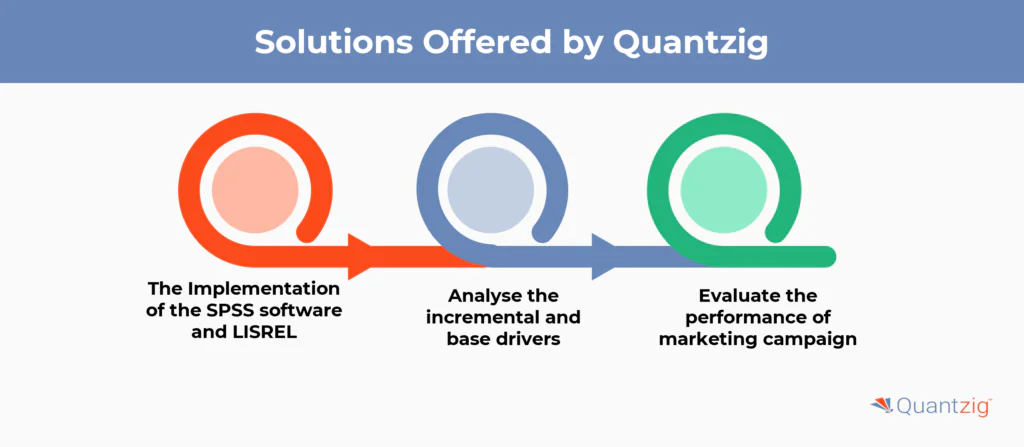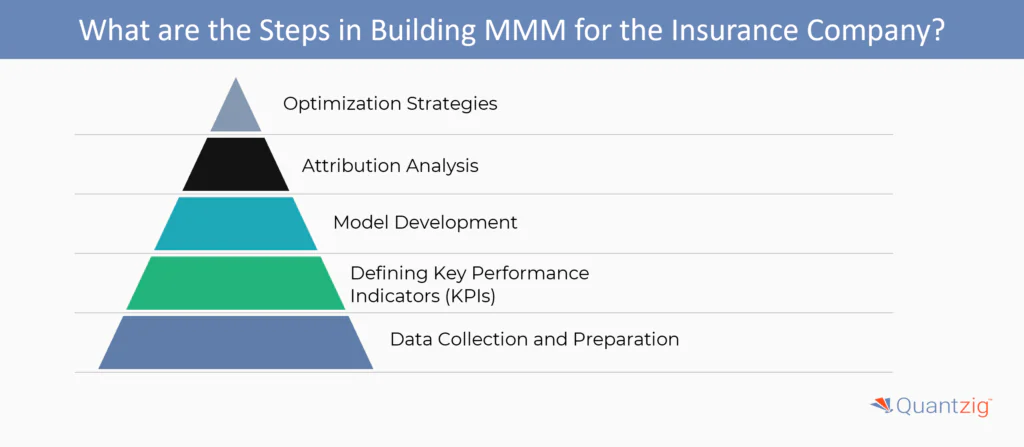Written By: Sudeshna Ghosh
Table of Contents
Introduction to Marketing Mix ROI Insurance
The significance of the marketing mix comes from the fact that a product or service’s ability to succeed or fail in the marketplace can also be linked to the effectiveness and precision of its marketing. Understanding how different marketing initiatives are impacting a product’s business metric is the main goal of a marketing mix model. Brands use it as a tool for decision-making to determine how well different marketing campaigns will increase marketing Return on Investment (ROI). This comprehensive guide contains all the information your business requires to understand the significance of the Insurance Marketing Mix and how to create an effective marketing mix strategy for your service.
Book a demo to experience the meaningful insights we derive from data through our analytical tools and platform capabilities. Schedule a demo today!
Request a Free DemoQuantzig’s Marketing Mix ROI Insurance Solution for a Leading Insurance Brand
| Category | Details |
|---|---|
| Client Details | A significant player in the insurance sector sought to optimize its marketing RoI. |
| Challenges Faced by the Client | Our client wanted to allocate its marketing budget more effectively to achieve its growth objectives. |
| Solutions Offered by Quantzig | We analyzed the data through the statistical package for the social sciences (SPSS) software and linear structural relations (LISREL) using descriptive and inferential statistical methods. Our consultants differentiated contributions from incremental drivers (price discounts, campaigns, and promotions) and base drivers (brand value accumulated over the years because of long-term marketing activities). |
| Impact Delivered | Quantzig’s research and insights enabled the client to direct its marketing spend toward the correct variables and increase its RoI by 43%. |
Client Details
A significant player in the insurance sector sought to optimize its marketing RoI.
The Challenges Faced by the Client
Our client wanted us to evaluate the impact of its marketing inputs to allocate its marketing budget better and achieve its marketing objectives, including a high marketing RoI. It had in the past tried to prioritize its marketing efforts based on its impact. However, the client’s marketing set-up lacked the knowledge and tools for evaluating and prioritizing marketing inputs to improve its brand name and equity. Quantzig consultants set up a process to explore the impact of the marketing mix variables on the client’s brand equity with the help of our unique MMM framework.
Marketing Mix ROI Insurance Solutions Offered by Quantzig
1. The Implementation of the SPSS software and LISREL
Our data science analysts performed Pierson correlation tests, regression, and path analysis on collected data to determine the relationship between the dependent and independent marketing mix variables. For this study, data was collected using questionnaires, and the statistical population included customers and representatives of our client. We analyzed the data through the statistical package for the social sciences (SPSS) software and linear structural relations (LISREL) using descriptive and inferential statistical methods.
2. Analyze the incremental and base drivers
Our consultants differentiated contributions from incremental drivers (price discounts, campaigns, and promotions) and base drivers (brand value accumulated over the years because of long-term marketing activities). In addition, our analysts prepared contribution charts to represent sales derived from each marketing input.
3. Evaluate the performance of marketing campaign
We used our findings to perform a deep-dive analysis to further assess our client’s effectiveness of every marketing campaign. This analysis was conducted on genre, language, and channel criteria. Our client considered the insights generated through our deep-dive research for budget optimization and shifted its marketing spend from low-performing genre/channels to high-performing genre/channels and increased overall sales and market share.
Impact Delivered using Quantzig’s Marketing Mix ROI Insurance Solution
Our findings showed that marketing mix variables impacted our client’s brand equity to different degrees and on different paths. The results showed that brand image, propaganda, and promotion had a higher impact on our client’s brand equity. We provided our client with the following insights:
- We identified the need to divert focus on promoting its brand image to increase its market share.
- We also established that propaganda was a significant variable impacting our client’s brand equity. We suggested our client use efficient propaganda strategies and design revenue-generating propaganda campaigns.
- Customers’ unfamiliarity with our client’s insurance policies and offerings stopped our client’s business from growing and developing. We advised the client to increase awareness about its products and highlight the advantages of its policies over those of its competitors.
Through the insights and suggestions offered by our consultants, our client was able to direct its marketing spend toward the correct variables and increase its RoI by 43%.
Quantzig’s Expertise in Marketing Mix ROI Insurance
The deployment of Quantzig’s marketing mix modeling solution enabled our client to optimize its marketing spend by directing focus on building its brand image and increase awareness of its products and their advantages. It could also identify the elements of successful campaigns and divert funds to channels that would help achieve a higher ROI. Our interventions led our client to achieve an increase in its RoI by 43% and placed it on the path to increasing this value over time. Our scientific, data-backed analysis helped our client extract maximum value from its marketing budget and establish a long-term strategy for its marketing activities.
Experience the advantages firsthand by testing a customized complimentary pilot designed to address your specific requirements. Pilot studies are non-committal in nature.
Request a Free PilotWhat is Marketing Mix Modeling (MMM)?
This is a data-driven analytical approach that evaluates the impact of various marketing elements on business outcomes. By analyzing historical data, MMM identifies the correlation between marketing inputs—such as advertising spend, promotions, and other activities—and key performance indicators (KPIs) like sales or brand awareness. This statistical tool provides valuable insights into the effectiveness of different marketing channels, guiding strategic decision-making to maximize ROI.
Game-Changing Solutions for the Insurance Industry
The insurance sector is highly competitive, with several players seeking to secure the trust and faith of their clients. In addition, in today’s tech-savvy world, the competition is not just local; it’s global. Customers do not even have to leave their house to get a quote and sign up for insurance policies. Therefore, an insurance company’s marketing plan for growth and success needs to deliver on various fronts, namely, firm image, product elements, price, distribution intensity, propaganda, and promotion. Moreover, the marketing strategy must span all media channels comprising print, television, and social media. Therefore, insurance marketing mix modeling (MMM) is necessary to understand and quantify the impact of various marketing channels.
Insurance companies seek new methods to increase their market share and improve customer satisfaction and loyalty in this fiercely competitive world. Thus, it has become necessary for insurance companies to use the (Marketing Analytics) MMM framework as a decision-making tool to estimate the effectiveness of each marketing input in terms of ROI.
Broad Perspective on Insurance Marketing Mix Segment
The changing marketing environments in the insurance industry have led to the emergence of new platforms where insurance marketers can actively engage with customers. This has also led to the emergence of new variables. Some of these include the following:
- Product/market trend: Product/market trend is a critical input that drives the baseline outcome and helps insurance companies understand the demand for a product.
- Policy launches: Insurance companies need to invest carefully to position their new policies in the market and plan effective marketing strategies to support such launches.
- Events and conferences: Insurance companies should look for opportunities to build long-lasting relationships with prospective clients and promote their policies and services through periodic events and conferences.
- Behavioral Metrics: Variables such as online behavior metrics and touch-points provide deeper insights into customers for insurance companies.
Get started with your complimentary trial today and delve into our platform without any obligations. Explore our wide range of customized, consumption driven analytical solutions services built across the analytical maturity levels.
Start your Free TrialImpact of variables on marketing mix models
This is a powerful analytical tool used to measure the impact of various marketing initiatives on a company’s ROI. By analyzing the elements—product, price, promotion, and place—businesses can develop a robust business strategy. This involves leveraging advanced market research and sophisticated market mix model development and techniques to enhance performance. Understanding how each variable affects overall marketing effectiveness is crucial for optimizing the marketing budget and improving marketing channel performance.
Price
Price is a critical variable in marketing mix models. It directly influences consumer purchasing decisions and impacts overall ROI. Accurate pricing strategies, developed through thorough market mix model development, ensure competitiveness and profitability. Marketing mix modeling helps in understanding the elasticity of price changes and their effect on sales, allowing for better marketing channel optimization and marketing budget allocation.
Product
The product is the core of any marketing mix strategy. It involves the features, quality, and benefits that meet customer needs. Analyzing the product helps businesses understand its market position and consumer perception. Effective marketing activities and market mix model techniques ensure that the product aligns with consumer expectations, enhancing overall marketing channel efficiency and ROI.
Promotion
Promotion encompasses all marketing initiatives aimed at increasing awareness and sales. This includes advertising, sales promotions, and public relations. In marketing mix models, promotion is analyzed to determine its impact on sales and marketing channel performance. By evaluating promotion strategies, businesses can optimize their marketing channel selection and strategy, ensuring maximum marketing channel impact and ROI.
Place
Place refers to the distribution channels used to deliver the product to consumers. Effective place strategies ensure that products are available in the right locations at the right times. Marketing mix modeling analyzes the efficiency of different marketing channels and their contribution to sales. This marketing channel analysis helps in refining marketing channel strategies and improving overall marketing channel performance.
Understanding the impact of price, product, promotion, and place through marketing mix modeling is essential for creating a successful marketing strategy. By leveraging detailed marketing channel data, businesses can gain valuable marketing channel insights and stay ahead of marketing channel trends. Continuous marketing channel forecasting and monitoring of marketing channel metrics ensure sustained marketing channel efficiency and ROI. Ultimately, a well-implemented model drives effective marketing initiatives, leading to improved marketing channel optimization and overall business success.
What are the Steps in Building Insurance Marketing Mix Modeling?
1. Data Collection and Preparation:
Gather comprehensive data on marketing expenditures, sales, and relevant variables. Ensure data accuracy and completeness for robust analysis.
2. Defining Key Performance Indicators (KPIs):
Identify specific business outcomes to optimize, such as policy sales or customer acquisition. Clearly define and quantify KPIs for effective measurement.
3. Model Development:
Employ statistical modeling techniques to establish relationships between marketing inputs and KPIs. Consider factors like seasonality and market trends for a refined model.
4. Attribution Analysis:
Determine the contribution of each marketing element to overall outcomes. Understand which channels and activities have the most significant impact on chosen KPIs.
5. Optimization Strategies:
Utilize MMM insights to reallocate marketing budgets based on the most effective channels. Identify areas for increased investment and streamline underperforming strategies, driving efficiency, and maximizing returns.
Conclusion
Marketing mix modeling is essential for optimizing the marketing mix and enhancing ROI. By analyzing marketing initiatives, product, price, promotion, and place, businesses can develop an effective strategy. Utilizing advanced market research and sophisticated market mix model development and techniques, insurance companies can accurately measure insurance marketing mix model performance. This analysis aids in making informed decisions on marketing activities and optimizing the marketing budget. By focusing on marketing channel selection, marketing channel optimization, and marketing channel strategy, businesses can improve marketing channel performance and efficiency.
Moreover, understanding marketing channel ROI, impact, and insights helps in better marketing channel analysis and forecasting. Monitoring marketing channel trends, metrics, and data ensures continuous improvement and alignment with market demands. Thus, Insurance Marketing Mix is a powerful tool for achieving superior marketing effectiveness and business success.






